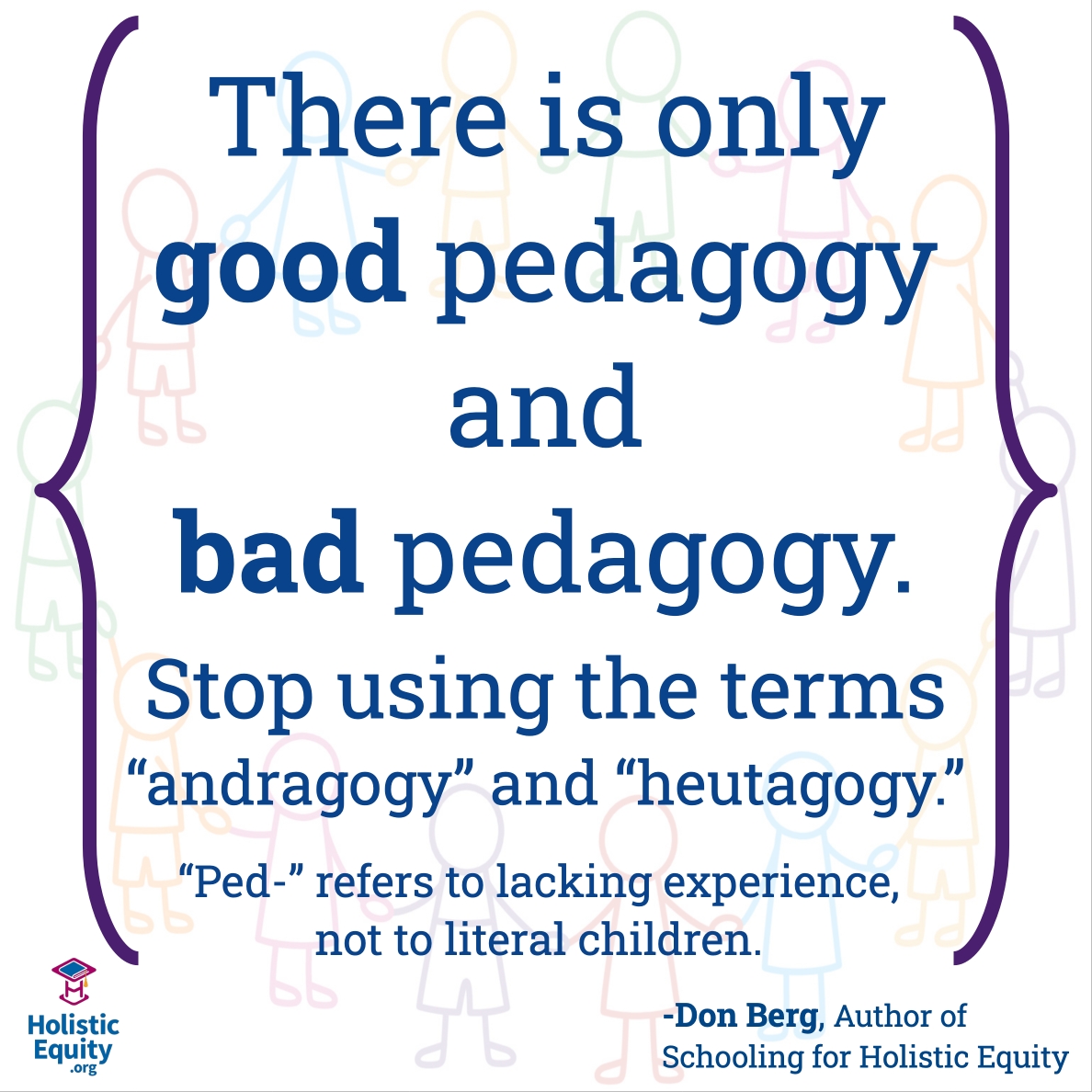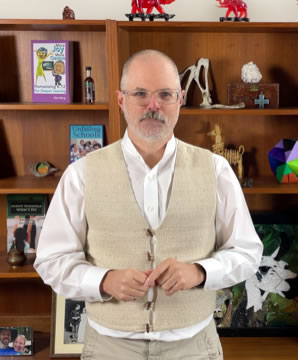Against Andragogy and Heutagogy

Andragogy and heutagogy are useless terms.
Please, stop using them.
The heart of my objection is that defining an idea by its opposite is a form of doublespeak; it’s dishonest.
There are some folks who are advocating for “andragogy” and/or “heutagogy” to replace “pedagogy” as the way that children are taught.
A few want teachers to stop using “pedagogy” because they believe that it necessarily produces bad outcomes for children.
Others seem to think that pedagogy should not be applied to adult learners because they supposedly have different needs than children.
So, instead of “pedagogy,” teachers of adults should practice andragogy.
Better yet the practice of “heutagogy” should replace both pedagogy and andragogy.
This only makes sense if pedagogy is defined as its opposite, which only works if you take actual teaching practice in most mainstream K-12 schools as defining of that term.
If, on the other hand, you take what is effective for the facilitation of children’s learning as what MUST define the term pedagogy, then all teaching practices which undermine children’s learning are relegated to the status of BAD pedagogy.
The pedagogical practices in most mainstream K-12 schools are BAD to the degree that they alienate children from learning and teachers from teaching.
The epidemic of disengagement that has been amply documented to affect about 70% of all teachers and students shows that there is a lot of bad pedagogy in the mainstream.
How Andragogy and Heutagogy Arose
Here’s how I understand the development of the ideas of andragogy and heutagogy.
Malcolm Knowles (1988) observed K-12 pedagogy in the 1940s through the 1980s.
He saw a set of teaching practices that he claimed were inadequate for serving the learning needs of adults.
He does not appear to have considered the possibility that those teaching practices were just bad pedagogy.
Instead of presenting his ideas as good pedagogy, he proposed the idea that adults are, in some fundamental educational sense, different from children.
Specifically, he was trying to help the instructors of adults, so he proposed that they needed to approach their teaching tasks in ways that would be different from how teachers of children approach the same tasks.
He laid out six principles for doing so.
He called the application of his principles andragogy.
More recently Stewart Hase and Chris Kenyon (2000) observed that andragogy is too teacher-determined, therefore it is not adequate, either.
They propose “heutagogy,” which is concerned with self-determined learning.
Today we now have what are implicitly supposed to be three distinct but presumably valid approaches to education: pedagogy, andragogy, and heutagogy.
I reject the presumption of equal validity.
The problem is that the actual practices observed in childrens’ classrooms were presumed to be effective, or at least validly regarded as “good pedagogy.”
That was a mistake.
Pedagogy Properly Defined
Let me be clear about my claims.
I take the “ped” in pedagogy to be referring to folks inexperienced with regard to a particular subject, skill, or other area of focus, as in the idea that they are novices.
All learners subjected to schooling are presumed to be novices in the areas they are studying.
The term is about figurative children, not literal ones.
Learning is facilitated by well-being and undermined by ill-being.
This is encoded in common law by obligating schools to take on in loco parentis, duty of care, responsibilities.
This means they have both legal and moral duties to nurture students as a precondition for pursuing their educational mission.
Those duties include supporting the primary psychological needs of learners because primary needs are the causal sources of well-being and thwarting them leads to ill-being.
It also turns out that primary humans needs are, by definition, sources of well-being across all ages, so there is no meaningful distinction between adults and children in this regard.
Schools that serve adults may not have the legal duty to act in loco parentis; however that is irrelevant because they still cannot achieve their educational mission unless they support the primary psychological needs of their students; age is just not relevant.
The observed instructional ineffectiveness that led to the coining of the terms andragogy and heutagogy were instances of students’ needs going unmet.
They were instances of BAD pedagogy.
The coinage of the new terms was covering over problems that the coiners did not have an ability to adequately articulate through a proper model of instruction.
In my books (Schooling for Holistic Equity and The Agentic Schools Manifesto) I propose that there are two key dimensions in a proper model of good instruction: the quality of experience and the structure of the situation.
Prior to this model critics of schooling did not seem to know how to talk about the quality of the experience that students were having as distinct from how the instructor was structuring the situation.
Using this model we can regard teaching practices that produce thwarted needs, poor quality motivations, and disengagement as invalid from a pedagogical perspective.
Because this perspective is derived from the role of primary human needs in learning, an adult is not educationally distinct from a child with regard to a subject in which they are a novice.
While it is true that adults have more quantity of experiences in life to draw upon, which is key to one of Knowles’ principles of andragogy, that does not give teachers of children an excuse to ignore those children’s prior life experiences.
What Knowles’ principles of “andragogy” elucidate are helpful principles for teaching anyone, not just adults.
The same holds true for “heutagogy.”
The principles apply to all students; age is not relevant.
Andragogy and Heutagogy were Accidents of History
My argument here is that generating new fancy terms was an unfortunate accident of history that we can now reject.
There is only good pedagogy and bad pedagogy.
Bad pedagogy fails to take the learners’ needs into account and/or fails to provide adequate structure.
Good pedagogy ensures that the quality of the student’s experience is good AND that the structure of the learning situation gives them adequate feedback to achieve their goals and aspirations.
The terms “andragogy” and “heutagogy” do not add anything useful to the conversation about the quality of instruction when both dimensions are taken into account.
Their advocates should turn their attention to fighting against bad pedagogies.
From this perspective arguing for “heutagogy” to entirely replace “pedagogy” can only be based on a misunderstanding of pedagogy.
Are teachers using good pedagogy that is structured appropriately to enable students to effectively pursue their own goals and aspirations while simultaneously providing them with a good quality of experience in the process?
If the children are miserable or disruptive, we have to first find out whether the pedagogy is good or bad.
Any pedagogical practice is good when the student’s primary psychological needs are being satisfied, their motivations are more autonomous than controlled, and their engagement is agentic, not merely behavioral.
Optimizing structure enables the pedagogy to transcend the term “good” by elevating it into the realms of excellence.
Misery and other negative emotions are just fine when they are experienced in the context of 1) satisfied needs, 2) autonomous motivations, and 3) agentic engagement.
Back when I trained in martial arts and dabbled in a little mountaineering there were plenty of negative emotions involved.
Negative emotions are part and parcel of the learning process and ongoing practice in many disciplines.
When those three features of the quality of experience are true then any and all emotions are acceptable from moment-to-moment.
Thinking about how this occurs for a group, we are talking about the climate and culture of the classroom and school.
Climate and culture are the group-level determinants of the quality of experience.
If students are disruptive, then there might be structural problems with the pedagogy.
The techniques of instruction that teachers specialize in are not the only relevant aspects of “structure.”
The structure also includes how and why the student came to be in front of that teacher in that classroom.
The structure of the situation refers to how decisions are made, who makes them, who can change them, and also how conflicts that arise out of those decisions are either resolved, ignored, or suppressed.
In most schools the structural stuff is often hidden from students and teachers; it is the hidden curriculum.
In short, the hidden curriculum is how brains interact with policies to create limitations on what can happen in a classroom.
(My book Schooling for Holistic Equity: How to Manage the Hidden Curriculum in K-12 presents it in more detail.)
Bad pedagogy usually arises from the rules of the game, not necessarily from the skills of the players (students) and their coaches (instructors).
The hidden curriculum is often the most significant barrier to good pedagogy.
When students are arbitrarily assigned to teachers or classes without regard to their individual goals, aspirations, needs, desires, preferences, etc. they cannot be reasonably be expected to learn deeply and in extreme cases they should not be expected to be obedient to arbitrary authorities.
In those extreme cases authorities must EARN the respect of their students.
I presume all teachers are doing the best they can with what they have.
They are constrained by the rules of the game that their school imposed upon them when they accepted the job.
When instructors are given too little time, assigned too many students, held “accountable” for other people’s behaviors, over scheduled, under prepared, etc. they cannot reasonably be expected to use good pedagogical practices, let alone ones that will enable them to attain excellence.
When they are prevented from providing adequate support for the psychological needs of all the children in their care, they may be forced to make a Sophie’s Choice by picking and choosing who will and will not receive support.
Schools too often operate within a set of rules that ties one arm behind everyone’s backs.
Even if that is thought to be totally normal, it is still bad pedagogy.
Making up new terms, like andragogy and heutagogy, is not helpful, so please stop using those terms.
From here on, call out bad pedagogy, promote good pedagogy, and if possible, aspire to achieve excellent pedagogy.
P.S. The term “heutagogy” MIGHT still be useful if you need to distinguish between learning that occurs without the guidance of a teacher from that which does, though I would encourage you to inquire into whether that distinction is real or imagined.
It is possible that all learning is actually self-directed since, despite appearances and cultural assumptions to the contrary, we are fundamentally referring to change processes in the brain.
If it is true that all learning is ultimately self-directed, the term “heutagogy" is not useful since the term pedagogy would already be a comprehensive description of the enabling conditions for effective learning, independent of the presence or absence of a teacher.
References
Hase, S. and Kenyon, C. (2000) From andragogy to heutagogy. Ulti-BASE In-Site, Vol. December, Royal Melbourne Institute of Technology. Retrieved from: https://researchportal.scu.edu.au/esploro/outputs/journalArticle/From-andragogy-to-heutagogy/991012821597602368
Knowles, M. S. (1988). The Modern Practice of Adult Education: From Pedagogy to Andragogy. Englwood Cliffs, NJ: Cambridge Adult Education.
This article was printed from HolisticEquity.com

